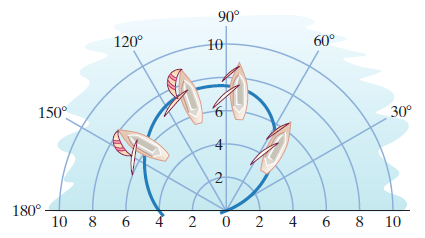
In Exercise Set 7.3, we considered an application in which sailboat racers look for a sailing angle to a 10-knot wind that produces maximum sailing speed. This situation is now represented by the polar graph in the figure shown. Each point

What angle to the wind produces the maximum sailing speed? What is the speed? Round the angle to the nearest five degrees and the speed to the nearest half knot.
Want to see the full answer?
Check out a sample textbook solution
Chapter 7 Solutions
Algebra & Trigonometry With Additional Material From College Algebra Essentials (custom Edition For Tidewater Community College)
- Pls help on botharrow_forwardCalcúlate the cross product of v and warrow_forwardConsider the following elevation function for a region of irregular terrain: z(x, y) = 1 x² + y² 25 Here, z is the elevation of the terrain over a point (x, y) with x and y being the horizontal coordinates. The region of interest lies between x = 0 and x = 5, and y 0 and y = 5. Your tasks are the following: = 1. Analyze how the elevation changes with respect to x and y. To find the elevation changes, calculate the partial derivatives of the elevation function z with respect to x and 2. Calculate the total volume of soil above the 0-level (z region of interest. = y. 0). To do so, integrate z(x, y) over the wholearrow_forward
- Algebra & Trigonometry with Analytic GeometryAlgebraISBN:9781133382119Author:SwokowskiPublisher:Cengage
 Trigonometry (MindTap Course List)TrigonometryISBN:9781337278461Author:Ron LarsonPublisher:Cengage Learning
Trigonometry (MindTap Course List)TrigonometryISBN:9781337278461Author:Ron LarsonPublisher:Cengage Learning Mathematics For Machine TechnologyAdvanced MathISBN:9781337798310Author:Peterson, John.Publisher:Cengage Learning,
Mathematics For Machine TechnologyAdvanced MathISBN:9781337798310Author:Peterson, John.Publisher:Cengage Learning,  Elementary Geometry For College Students, 7eGeometryISBN:9781337614085Author:Alexander, Daniel C.; Koeberlein, Geralyn M.Publisher:Cengage,
Elementary Geometry For College Students, 7eGeometryISBN:9781337614085Author:Alexander, Daniel C.; Koeberlein, Geralyn M.Publisher:Cengage, Elementary Geometry for College StudentsGeometryISBN:9781285195698Author:Daniel C. Alexander, Geralyn M. KoeberleinPublisher:Cengage Learning
Elementary Geometry for College StudentsGeometryISBN:9781285195698Author:Daniel C. Alexander, Geralyn M. KoeberleinPublisher:Cengage Learning




